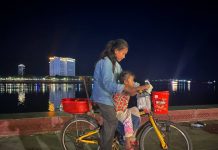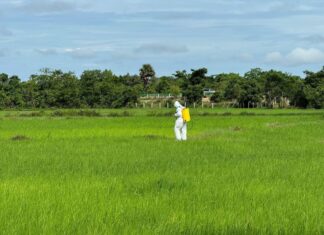Andy Brouwer is an independent researcher from the U.K. He first visited Cambodia in November 1994 and moved permanently to Phnom Penh in 2007, when he began working at Hanuman Films, a local production company.
Hong Sengly, a journalism trainee at Newsroom Cambodia, talks to Andy about his 30 years of adventures in Cambodia.
Q: Can you recall the feeling when you first stepped foot on Cambodian soil 30 years ago?
A: I’d been planning on coming to Cambodia for a long time. I first found out about Cambodia in 1979, when I watched “Year Zero: The Silent Death of Cambodia” by John Pilger. In the 1980s I joined a couple of social groups, Action Cambodia and Friends of Cambodia.
It wasn’t until the U.N. came in 1993 that I felt confident about coming here on my own. I came for five days: two days in Phnom Penh and three in Siem Reap. I wasn’t sure what to expect because I’d never been to Asia before. I’d only been to Europe. I had to organize someone to drive me around, my hotels and tour guides, all from England, all by letter — not by phone, not by email — but through the post.
When I arrived at the airport in Phnom Penh it was chaotic. Everybody got off the plane, walked into a small, little building and wandered around, then got their bags and went straight out. But my bags never appeared. I tried to speak to someone, “My bags, my bags.” I really didn’t know what to do, so I followed the crowds outside, where there was just a sea of faces staring at me. At the time, whenever a plane landed, crowds of people would go to the airport to watch. I walked out of the airport, worried about my bags, into literally a sea of faces.
I saw a guy with a sign — “Mr. Andy” — who had come to pick me up. We drove through the streets of Phnom Penh, which in those days were mostly unpaved. It was a little crazy.
Q: You’ve posted a lot about Cambodia’s temples, culture and history. What makes you so passionate?
A: I’ve always loved history, and wherever I’ve gone in the world I’ve always visited the museums and historical places, because that’s an essential part of any country.
When I heard about Cambodia’s incredible history, I wanted to know more, but it was very difficult to find anything. So the idea of coming here, and getting a better understanding of the temples, the history, was very appealing.
In those earlier days, it was the adventure of getting to a temple and seeing what was left, then going to another, but all the time having an adventure and meeting people.
One of the biggest attractions were the people. The temples were wonderful, and the experiences I had were fantastic, but it was the people who really made the country attractive. Everywhere I went they were happy to see me. They were happy to interact.
Q: You visited some very remote places, like Koh Ker temple, during the early 2000s. What was that like?
A: I wanted to explore beyond Phnom Penh and Siem Reap, to get into the countryside, and I needed somebody to take me, without spending too much money. The easiest way was by motorbike. So in Siem Reap, Phnom Penh, Kampong Thom, Battambang, I made friends with moto drivers who could speak a bit of English. I would go to Kampong Thom and use it as a base for exploring Preah Vihear, Koh Ker, Preah Khan and Kampong Svay.
The thing for me was making friends. I would go and eat with their families, take them to restaurants, get to know the families, and most are still friends today.
So I had friends all over, and we would go and search for these ancient temples, many of them just piles of dirt and rock, but some were amazing. We had such fantastic adventures. I didn’t drive, I rode on the back — and we would go off for days, staying in peoples’ homes or small guest houses, and hopefully find these ancient temples in the forest, miles from anywhere.
The feeling of being probably the first Westerner to see those temples in 100 years, for me that was the excitement, but it also meant I met a wide variety of Cambodians. In some villages, they had never seen a foreigner before, and the kids would all run away and hide. It was just a great way to get to see the real Cambodia.
I didn’t mention the traveling: It was really difficult, it would take seven hours to get from Kampong Thom to Preah Vihear town on a bumpy dirt road. We would be covered in red dust. But that’s okay, because I made sure we stopped at as many places as possible to say hello to people.
Q: You talk often about the movie “The Killing Fields.” What does the film mean to you?
A: The film was released at the end of 1984, so I saw it in 1985, and it gave me my first real understanding of what had happened during the Khmer Rouge period. I had read some reports, but I don’t remember any books about Cambodia at that time. It was a dramatic interpretation of what had happened during the period.
The film made it accessible for people like me, who lived in the West and had no idea of what was happening in Asia. The film made it easier for us to understand, and to appreciate, some of what the Cambodians had gone through. But at the same it was difficult, because it was Cambodians with Cambodians. It’s difficult to understand. But “The Killing Fields” was an absolutely vital part of my understanding of Cambodia. So it was a really big deal.
Luckily, I’ve been able to meet the director and some of the actors in the film. Because it had such a big impact on me, I still like to write about it. This year will be the 40th anniversary of its release, so it’s an important year.
Q: You have a page on your website dedicated to British deminer Christopher Howes. How did his story impact you?
A: Did you know there’s a street named after Christopher Howes? It’s in front of the National University of Management.
Christopher Howes is what we would call a typical British hero. Christopher Howes came from a place called Bristol, which is very close to where I used to live. In fact, after he died, and they found the body many years later, his father sent me a message and asked me to go to the funeral. Unfortunately, I couldn’t go.
When I came to live in Cambodia, the men who killed him were on trial. I went every day because I thought it was very important. He had come to Cambodia to help demine the country, to make land accessible to Cambodian families so they could live their lives and grow crops. Demining is dangerous enough work, without being kidnapped by the Khmer Rouge.
The story is, his demining group was stopped by Khmer Rouge soldiers in a remote area. They said, “You go back, because you’re a foreigner. You go back to your base and get some money and bring it to us, and we’ll let your people go.” He refused to leave his team. He said no, you let my guys go, and I will stay here until they come back.
He put himself as the one to suffer, rather than his men. That’s a typical British attitude. Unfortunately, only a couple of days later, it appears that the Khmer Rouge commander in Anlong Veng gave the order to kill him.
British police came to investigate. They got the names of the people who did it and, almost 10 years later, a senior Khmer Rouge commander named Khem Nguon was sentenced to prison for his murder.
The page on my website is dedicated to Christopher Howes because he had all the attributes of a true British hero, helping a country that I loved and still love.
Q: You’ve talked a lot about Douglas Latchford, the British art dealer and smuggler. How did he shape Cambodia?
A: This is an ongoing story. For many decades, Douglas Latchford was getting hold of Cambodian sculptures and selling them across the world. He would pay people in Cambodia to steal the sculptures and smuggle them across the border.
He did this for 50 years or so, and he was able to take thousands of sculptures out of Cambodia while giving the Cambodian looters a tiny bit of money. Then, he would sell them for hundreds of thousands of dollars; so, he made millions, many millions, doing this.
Everybody thought he was a nice guy because he donated money to the National Museum. He would improve their lighting, or he would give them a few sculptures. That’s the way he did it.
He brought great disgrace on the U.K. Over the past few years, I’ve posted a lot on Douglas Latchford and his activities. I’ve posted many pictures of the stolen sculptures as a way of trying to regain some of the lost ground. He did a lot of bad things to Cambodia and I want everybody to know it.
I post on Facebook because a lot of Cambodians read Facebook. I want Cambodians to know about their culture, that it’s overseas in this museum, in that museum, and has been stolen by people like Latchford. Because it’s important we recognize the amazing ability of the Cambodians of the Angkor period. But many of these fantastic sculptures have left Cambodia, and to see them you must go to London or New York or Australia or France.
The Cambodian government is doing a fantastic job of getting them back. Other countries are looking at Cambodia and saying, “Wow, Cambodia is doing a brilliant job in finding and getting these museums and collectors to return these pieces.”
Q: It’s been 30 years since you first visited Cambodia. What are the biggest changes you’ve seen?
A: The most obvious thing is the construction in Phnom Penh. I’ve lived in Boeng Keng Kong for 16 years, and when I first moved here there were not any condominiums or any high buildings. It was all mostly villas.
Things like roads are much better. I remember those terrible roads I used to travel on. At least now, when you go to the main areas the roads are reasonable. The airports have improved.
The obvious things have improved, but the people are the same, which is the essence of Cambodia. I think they’re still as welcoming and as happy to see me as before. It’s the people that make the country.
Note: The interview has been lightly edited for length and clarity.












